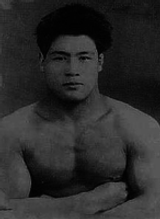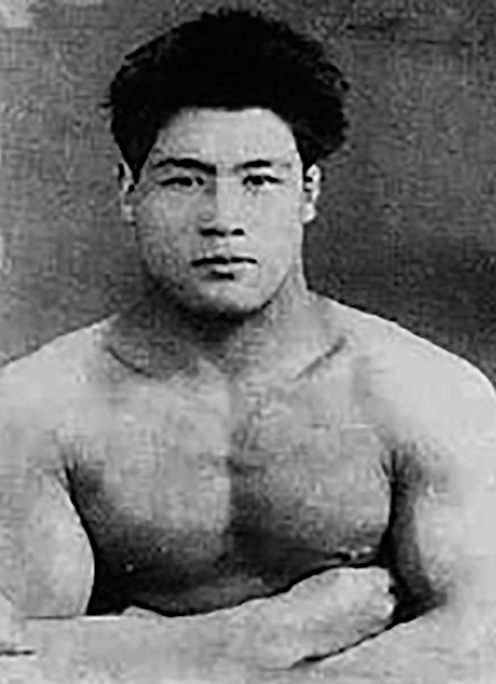Masahiko Kimura

Masahiko Kimura 1917 – 1993
“The Great Kimura”
 Masahiko Kimurawas a Japanesejudoka (Judo practitioner) considered one of the greatest judoka
of all time. In submission grappling the reverse ude-garami arm lock is often called the "Kimura", due to his
famous victory over Helio Gracie. Masahiko Kimura began Judo at age 9, and was promoted to yondan
(4th dan) at age 15 . In 1935 at age 18 he became the youngest ever godan (5th
degree black belt) when he defeated eight consecutive opponents at Kodokan (headquarters
for the governing body of Judo).Kimura's remarkable success is attributed
to his fanatical training regimen, managed by his teacher, Tatsukuma Ushijima.Kimura reportedly lost only four judo matches in his lifetime, all
occurring in 1935. Extremely
disappointed with the losses, he began training with a newfound determination. He
consistently practiced his special leg throw Osotogari (large outer
reap) against a tree, his Seoinage, and Ouchigari. Daily randori or sparring
sessions at Tokyo Police and Kodokan dojos resulted in
numerous opponents suffering from concussions and losing
consciousness, and Kimura received many requests not to use his osoto gari. In scheduled rematches, Kimura would
eventually defeat the four responsible for his lifetime losses.
Masahiko Kimurawas a Japanesejudoka (Judo practitioner) considered one of the greatest judoka
of all time. In submission grappling the reverse ude-garami arm lock is often called the "Kimura", due to his
famous victory over Helio Gracie. Masahiko Kimura began Judo at age 9, and was promoted to yondan
(4th dan) at age 15 . In 1935 at age 18 he became the youngest ever godan (5th
degree black belt) when he defeated eight consecutive opponents at Kodokan (headquarters
for the governing body of Judo).Kimura's remarkable success is attributed
to his fanatical training regimen, managed by his teacher, Tatsukuma Ushijima.Kimura reportedly lost only four judo matches in his lifetime, all
occurring in 1935. Extremely
disappointed with the losses, he began training with a newfound determination. He
consistently practiced his special leg throw Osotogari (large outer
reap) against a tree, his Seoinage, and Ouchigari. Daily randori or sparring
sessions at Tokyo Police and Kodokan dojos resulted in
numerous opponents suffering from concussions and losing
consciousness, and Kimura received many requests not to use his osoto gari. In scheduled rematches, Kimura would
eventually defeat the four responsible for his lifetime losses.
 At the height of his career, his training
involved a thousand push-ups and nine-hours practice every day. Promoted to 7th dan at age 30, his rank was frozen
after disputes with Kodokan over becoming a professional wrestler, refusing to
return the All Japan Judo Championship Championship flag, and issuing dan ranks
while in Brazil. Professional Judo
Champion (1950), Kimura learned legitimate Catch-As-Catch-Can while working as
a wrestler for Rikidozan. He also
entered Karate in his pursuit of martial arts, believing that karate would
strengthen his hands. He trained for two years in what is known today as Shotokan Karate under
founder Gichin Funakoshi, switching to Goju-Ryu Karate under Korean
master So-Nei Chu (a pupil of Goju-ryu karate legend Chojun Miyagi and highest
ranking Goju-kai sensei under Gogen Yamaguchi).
He finally became assistant instructor,
along with Gogen Yamaguchi and Masutatsu Oyama in his dojo (the latter also going to university together with
him and Aikido master Gozo Shioda). In his Autobiography, Kimura attributes the use of the makiwara (a karate
training implement) as taught to him by So Neichu and Masutatsu Oyama, as being
a significant contributor to his tournament success. He reportedly began using the makiwara daily,
prior to his first All Japan success in 1935, and never lost another
competition bout.
At the height of his career, his training
involved a thousand push-ups and nine-hours practice every day. Promoted to 7th dan at age 30, his rank was frozen
after disputes with Kodokan over becoming a professional wrestler, refusing to
return the All Japan Judo Championship Championship flag, and issuing dan ranks
while in Brazil. Professional Judo
Champion (1950), Kimura learned legitimate Catch-As-Catch-Can while working as
a wrestler for Rikidozan. He also
entered Karate in his pursuit of martial arts, believing that karate would
strengthen his hands. He trained for two years in what is known today as Shotokan Karate under
founder Gichin Funakoshi, switching to Goju-Ryu Karate under Korean
master So-Nei Chu (a pupil of Goju-ryu karate legend Chojun Miyagi and highest
ranking Goju-kai sensei under Gogen Yamaguchi).
He finally became assistant instructor,
along with Gogen Yamaguchi and Masutatsu Oyama in his dojo (the latter also going to university together with
him and Aikido master Gozo Shioda). In his Autobiography, Kimura attributes the use of the makiwara (a karate
training implement) as taught to him by So Neichu and Masutatsu Oyama, as being
a significant contributor to his tournament success. He reportedly began using the makiwara daily,
prior to his first All Japan success in 1935, and never lost another
competition bout.
Shortly after defending his All Japan title in 1949, Kimura accepted the position as Chief Judo Instructor for the metropolitan police in Tokyo. That same year, he accepted an invitation by Helio Gracie, of the renowned Gracie Ju Jitsu family, challenging him to a fight in Brazil. In a post-fight interview, Carlos Gracie revealed that Helio agreed to the fight to see how Kimura would be able to overcome him technically. Against Judo rules, an agreement was made that throws and pins would not count towards victory only a loss of consciousness. The fight took place in 1951, with Kimura defeating Helio Graci in a submission wrestling judo match. Kimura repeatedly used the Ippon Seoinage (one arm shoulder throw), the Osoto Gari (inner reap), the uchimata (inner thigh throw) and Harai Goshi (sweeping hip/loin throw), and his famous double wrist lock (ude Garami), named the Kimura lock by Brazilian practitioners. Kimura also used painful suffocating grappling holds such as Kuzure-kamishiho-gatame, Kesa-gatame, and Sankaku-gatame. Gracie proved to be a formidable opponent, able to perform despite two complete breaks to his left arm, and refusing to tap out. Finally a white towel was thrown. Kimura was declared the winner by TKO. Helio reportedly described his performance in the 1951 fight with Kimura as helpless, stating that during the fight he was choked unconscious and would have died if Kimura had not released the choke. Kimura would later applaud Gracie’s tremendous will to win.
In 1960, Kimura returned to teach Judo at Takushoku University. He trained a number of world class Judokas including Douglas Rogers (Canadian silver medalist at Tokyo Olympics), Masaki Nishimura (bronze medalist at Munich Olympics), and Kanei Watsuri (All Japan Champion 1970).
